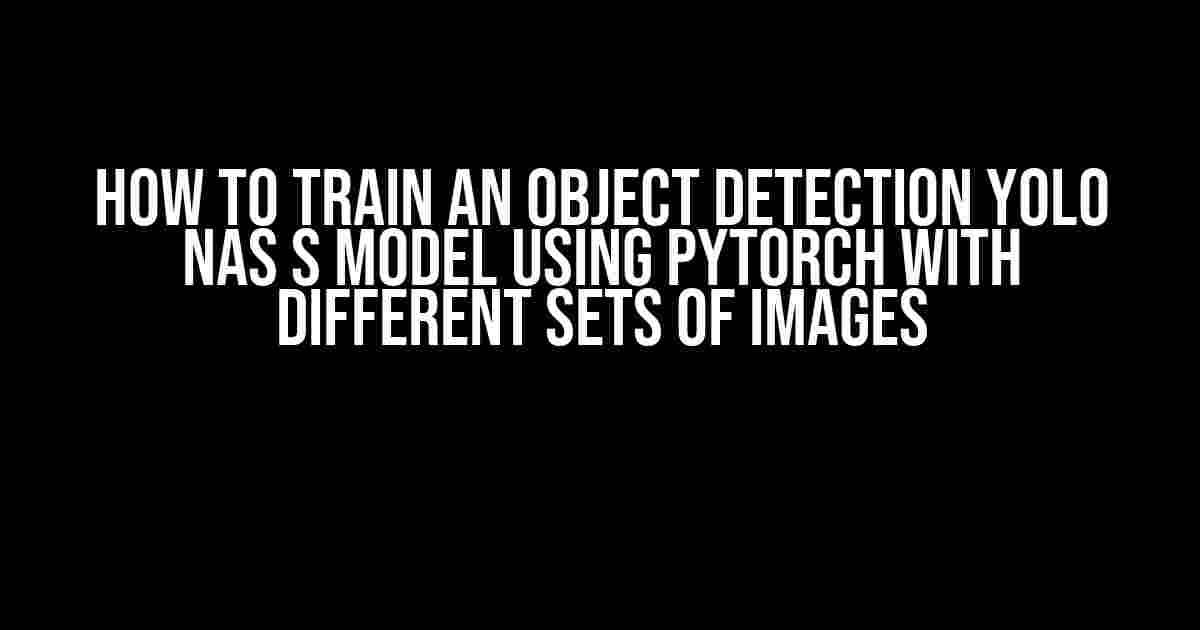Object detection has become a crucial task in the field of computer vision, and YOLO (You Only Look Once) is one of the most popular algorithms used for this purpose. In this article, we’ll explore how to train an object detection YOLO NAS S model using PyTorch with different sets of images. But before we dive in, let’s take a quick look at what YOLO and NAS S are.
What is YOLO?
YOLO is a real-time object detection system that detects objects in one pass without region proposal networks (RPNs) or post-processing. It’s a fast and accurate algorithm that has been widely used in various applications, including self-driving cars, surveillance systems, and robotics.
What is NAS S?
NAS S (Neural Architecture Search S) is a neural architecture search algorithm that allows us to automatically design neural networks for a given task. In the context of object detection, NAS S can be used to search for the optimal architecture of a YOLO model.
Prerequisites
Before we start training our YOLO NAS S model, make sure you have the following prerequisites installed:
- Python 3.x
- PyTorch 1.x
- OpenCV 4.x
- A GPU with at least 8GB of VRAM
- A dataset of images for training and testing
Step 1: Prepare the Dataset
The first step in training an object detection YOLO NAS S model is to prepare the dataset. You can use a pre-existing dataset or create your own dataset of images. For this example, we’ll use the PASCAL VOC dataset, which consists of 20 object classes.
To prepare the dataset, follow these steps:
- Download the PASCAL VOC dataset from the official website.
- Extract the dataset to a directory, for example,
/path/to/voc2007. - Create a text file, for example,
voc2007.txt, that contains the paths to all the images in the dataset. - Split the dataset into training and testing sets, for example, 80% for training and 20% for testing.
Step 2: Install the Required Libraries
Next, install the required libraries using pip:
pip install torch torchvision opencv-python
Step 3: Implement the NAS S Algorithm
Now, let’s implement the NAS S algorithm using PyTorch. We’ll use the nas library, which provides an implementation of NAS S in PyTorch.
import torch from nas import NAS # Initialize the NAS S algorithm nas = NAS(num_layers=6, num_cells=4)
Step 4: Define the YOLO Model
Next, let’s define the YOLO model using PyTorch. We’ll use the yolo library, which provides an implementation of YOLO in PyTorch.
import torch from yolo import YOLO # Initialize the YOLO model model = YOLO(num_classes=20, image_size=416)
Step 5: Train the YOLO NAS S Model
Now, let’s train the YOLO NAS S model using the prepared dataset and the implemented NAS S algorithm and YOLO model.
import torch
from torch.utils.data import DataLoader
from torchvision.datasets import VOC2007
# Load the dataset
dataset = VOC2007('/path/to/voc2007', 'train')
data_loader = DataLoader(dataset, batch_size=16, shuffle=True)
# Train the model
for epoch in range(100):
for batch in data_loader:
# Get the images and labels
images, labels = batch
# Forward pass
outputs = model(images)
# Calculate the loss
loss = nas.loss(outputs, labels)
# Backward pass
loss.backward()
# Update the model parameters
optimizer = torch.optim.SGD(model.parameters(), lr=0.01)
optimizer.step()
# Print the loss
print(f'Epoch {epoch+1}, Loss: {loss.item()}')
Step 6: Evaluate the YOLO NAS S Model
Once the model is trained, let’s evaluate its performance on the testing set.
import torch
from torch.utils.data import DataLoader
from torchvision.datasets import VOC2007
# Load the testing set
dataset = VOC2007('/path/to/voc2007', 'test')
data_loader = DataLoader(dataset, batch_size=1, shuffle=False)
# Evaluate the model
accuracies = []
for batch in data_loader:
# Get the images and labels
images, labels = batch
# Forward pass
outputs = model(images)
# Calculate the accuracy
accuracy = nas.accuracy(outputs, labels)
# Append the accuracy to the list
accuracies.append(accuracy)
# Print the average accuracy
print(f'Average Accuracy: {sum(accuracies) / len(accuracies)}')
Conclusion
In this article, we’ve covered how to train an object detection YOLO NAS S model using PyTorch with different sets of images. We’ve also explored the basics of YOLO and NAS S, and demonstrated how to implement and train a YOLO NAS S model using PyTorch.
Remember to tune the hyperparameters, such as the learning rate and batch size, to achieve the best performance. You can also experiment with different architectures and loss functions to improve the accuracy of the model.
| Keyword | Description |
|---|---|
| YOLO | You Only Look Once, a real-time object detection algorithm |
| NAS S | Neural Architecture Search S, a neural architecture search algorithm |
| PyTorch | A popular deep learning framework |
| Object Detection | The task of detecting objects in images or videos |
By following this article, you should be able to train an object detection YOLO NAS S model using PyTorch with different sets of images. Happy training!
Frequently Asked Question
Get ready to unleash the power of object detection with YOLO NAS-S and PyTorch! Here are the most frequently asked questions about training this robust model with a diverse set of images:
What is the ideal dataset size and diversity for training a robust YOLO NAS-S model?
Aim for a dataset with at least 1,000 to 5,000 images, comprising a diverse range of objects, angles, lighting conditions, and backgrounds. This diversity will help the model generalize better and detect objects more accurately.
How do I preprocess the images for training a YOLO NAS-S model?
Resize the images to a fixed size (e.g., 416×416), normalize the pixel values between 0 and 1, and convert the images to RGB format. You can also apply data augmentation techniques like flipping, rotating, and cropping to further enhance the model’s robustness.
What is the recommended architecture and hyperparameter settings for training a YOLO NAS-S model using PyTorch?
Use the YOLO NAS-S architecture with a backbone network like CSPDarknet53, and set the hyperparameters as follows: batch size = 8, learning rate = 0.001, momentum = 0.9, weight decay = 0.0005, and number of epochs = 100. Fine-tune these settings based on your dataset and computational resources.
How do I evaluate the performance of my YOLO NAS-S model during training?
Monitor the model’s performance using metrics like mAP (mean average precision), AP (average precision), precision, recall, and F1-score on a validation set. You can also use visualization tools like TensorBoard or PyTorch’s built-in visualization features to track the model’s performance and adjust the hyperparameters accordingly.
Can I use transfer learning to fine-tune a pre-trained YOLO NAS-S model on my custom dataset?
Yes, you can leverage transfer learning by fine-tuning a pre-trained YOLO NAS-S model on your custom dataset. Freeze the weights of the pre-trained model and update the final layers to adapt to your dataset. This approach can significantly reduce training time and improve the model’s performance on your specific object detection task.


